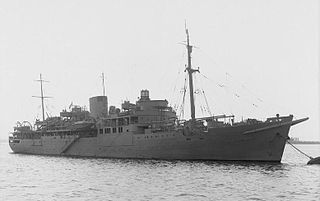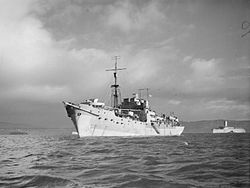
HMS Kelvin was a K-class destroyer of the Royal Navy laid down by the Fairfield Shipbuilding and Engineering Company, Limited, at Govan in Scotland on 5 October 1937, launched on 19 January 1939 and commissioned on 27 November 1939 with the pennant number F37.

RFA Argus is a ship of the Royal Fleet Auxiliary operated by the Ministry of Defence under the Blue Ensign. Italian-built, Argus was formerly the container ship MVContender Bezant. The ship was requisitioned in 1982 for service in the Falklands War and purchased outright in 1984 for a four-year conversion to an Aviation Training Ship, replacing RFA Engadine. In 1991, during the Gulf War, she was fitted with an extensive and fully functional hospital to assume the additional role of Primary Casualty Receiving Ship. In 2009, the PCRS role became the ship's primary function. Argus is due to remain in service beyond 2030. In July 2022 it was reported that the future Littoral Strike Role would be assumed by Argus after a refit to convert her to this role.

Dazzle camouflage, also known as razzle dazzle or dazzle painting, is a family of ship camouflage that was used extensively in World War I, and to a lesser extent in World War II and afterwards. Credited to the British marine artist Norman Wilkinson, though with a rejected prior claim by the zoologist John Graham Kerr, it consisted of complex patterns of geometric shapes in contrasting colours interrupting and intersecting each other.

HMCS Rimouski was a Royal Canadian Navy Flower-class corvette which took part in convoy escort duties during the Second World War. She fought primarily in the Battle of the Atlantic. She was named after Rimouski, Quebec.

HMS Argonaut was a Dido-class cruiser of the British Royal Navy which saw active service during the Second World War. Constructed at the Cammell Laird shipyard, Birkenhead, Argonaut was laid down in 1939, launched in September 1941, and formally commissioned into service on 8 August 1942.

HMS Halcyon was the lead ship in her class of minesweepers built for the Royal Navy in the 1930s. The vessel was launched on 20 December 1933 and was used as a convoy escort and during the landing operations during the Invasion of Normandy during World War II. The ship was sold for scrapping in 1950.

HMS Boadicea was a B-class destroyer built for the Royal Navy (RN) around 1930. Initially assigned to the Mediterranean Fleet, she was transferred to the Home Fleet in 1936. Before her departure, the ship evacuated civilians from Spain during the beginning of the Spanish Civil War of 1936–1939. Boadicea later spent considerable time in Spanish waters, enforcing the arms blockade imposed by Britain and France on both sides of the conflict. During World War II, the ship spent the bulk of the war on convoy escort duty in British waters and participated in the Battle of the Atlantic, Operation Torch, the Russian Convoys, and in the Normandy landings. Badly damaged by German dive bombers in 1940, she was sunk almost exactly four years later by German aircraft.

The Shoreham-class sloops were a class of eight warships of the Royal Navy built in the early 1930s.
Completed in 1936, HMS Royal Ulsterman was a 3,250 ton passenger ship which, along with her sister-ship, Royal Scotsman, sailed the Glasgow-Belfast run for Burns and Laird Lines Ltd. During the Second World War, Royal Ulsterman served as a commissioned Royal Navy troop transport, taking part in nearly all of the major Allied amphibious operations of the European war, including the Dunkirk evacuation; Operation Neptune ; and the liberation of the Channel Islands.

Ship camouflage is a form of military deception in which a ship is painted in one or more colors in order to obscure or confuse an enemy's visual observation. Several types of marine camouflage have been used or prototyped: blending or crypsis, in which a paint scheme attempts to hide a ship from view; deception, in which a ship is made to look smaller or, as with the Q-ships, to mimic merchantmen; and dazzle, a chaotic paint scheme which tries to confuse any estimate of distance, direction, or heading. Counterillumination, to hide a darkened ship against the slightly brighter night sky, was trialled by the Royal Canadian Navy in diffused lighting camouflage.

Counter-illumination is a method of active camouflage seen in marine animals such as firefly squid and midshipman fish, and in military prototypes, producing light to match their backgrounds in both brightness and wavelength.
HMS Royal Scotsman, originally the MV Royal Scotsman, was an LSI of the British Royal Navy that served during World War II. A former passenger ferry, she saw action in the Mediterranean during the invasions of North Africa, Sicily and Italy.

Diffused lighting camouflage was a form of active camouflage using counter-illumination to enable a ship to match its background, the night sky, that was tested by the Royal Canadian Navy on corvettes during World War II. The principle was discovered by a Canadian professor, Edmund Godfrey Burr, in 1940. It attracted interest because it could help to hide ships from submarines in the Battle of the Atlantic, and the research project began early in 1941. The Royal Navy and the US Navy carried out further equipment development and trials between 1941 and 1943.
During the Second World War, the Royal Navy commissioned several headquarters ships, which were responsible for communication between aircraft, ships and shore during amphibious operations. The first such recognised ship was HMS Bulolo.

HMS Bulolo was a 6,267 ton passenger and cargo ship of the Burns, Philp Shipping Company operating in the South Pacific. In 1939 she was converted into an Armed Merchant Cruiser, then a Landing Ship Headquarters (LSH) in 1942. She directed the landings in North Africa, Sicily, Anzio and Normandy during World War II.
HMS Coreopsis was a Flower-class corvette, built for the Royal Navy during the Second World War which served in the Battle of the Atlantic. In 1943, she was transferred to the Royal Hellenic Navy as RHNS Kriezis and participated in the 1944 Invasion of Normandy. Shortly before she was scrapped, she took part in the British war film, The Cruel Sea.

HMS Tamar is a Batch 2 River-class offshore patrol vessel of the Royal Navy. Named after the River Tamar in England, this is the seventh Royal Navy ship to be named Tamar. She is the fourth Batch 2 River-class vessel to be built and is forward deployed long-term to the Indo-Pacific region with her sister ship HMS Spey.

HMS Alisma was a Flower-class corvette that served in the Royal Navy.

HMS Dianella was a Flower-class corvette of the Royal Navy. She served during the Second World War.

HMS Mourne (K261) was a River-class frigate of the Royal Navy (RN). Mourne was built to the RN's specifications as a Group II River-class frigate. She served in the North Atlantic during World War II.
















